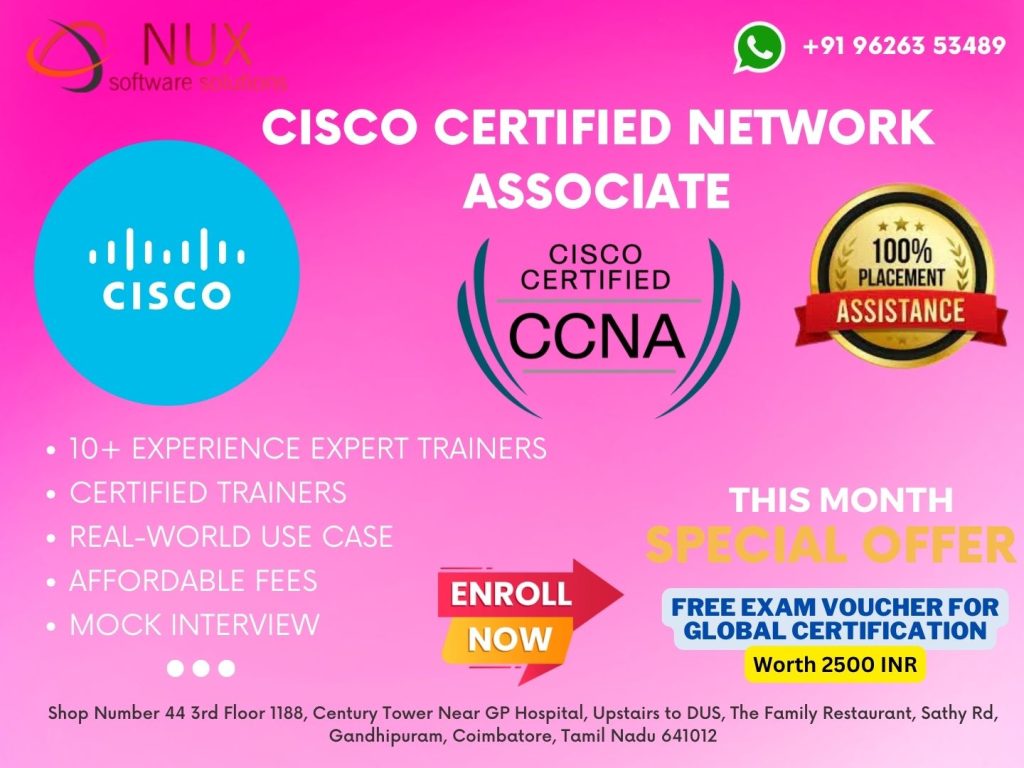Troubleshooting Cisco Data Center Infrastructure (DCIT 300-615)

Troubleshooting Cisco Data Center Infrastructure (DCIT 300-615) Training in Coimbatore
Course Overview
The Troubleshooting Cisco Data Center Infrastructure (DCIT 300-615) course is designed to equip data center professionals with the essential skills to diagnose, isolate, and resolve complex issues in enterprise-level data center environments. As one of the concentration exams for the CCNP Data Center certification, this training focuses on real-world problem-solving across Cisco’s data center technologies including NX-OS, ACI, and UCS.
At Linux Training Center in Coimbatore, our DCIT course provides immersive, hands-on learning that enables participants to confidently troubleshoot routing, switching, storage, compute, and automation within Cisco-powered data centers. Whether you’re pursuing CCNP Data Center or want to strengthen your operational knowledge, this course is a vital asset for your career in data center operations.
Why Choose DCIT 300-615?
Modern data centers are the backbone of digital enterprises. As environments grow more dynamic and complex, the demand for professionals who can quickly resolve disruptions is higher than ever. The DCIT certification validates your ability to troubleshoot infrastructure components and optimize uptime across Cisco Nexus, MDS, ACI, and UCS platforms.
This course goes beyond exam prep—it develops your real-time diagnostic expertise so you can reduce downtime, minimize impact, and maintain performance in mission-critical systems.
Who Should Enroll?
This course is ideal for:
Data Center Network Engineers and Administrators
System Engineers and Support Professionals
Cloud Infrastructure Engineers
IT Operations Engineers
Professionals pursuing CCNP Data Center certification
Learners should have a solid understanding of data center networking concepts and familiarity with Cisco UCS, ACI, and NX-OS.
What You Will Learn
Troubleshooting Layer 2/Layer 3 technologies on Cisco Nexus switches
Identifying and resolving issues in OSPF, BGP, VXLAN, and VPC
Diagnosing ACI fabric policy and connectivity problems
Storage network troubleshooting on Cisco MDS switches
UCS compute platform and service profile issue resolution
Integration and automation-related troubleshooting
Leveraging logs, SNMP, and telemetry for rapid diagnostics
Effective use of troubleshooting tools and methodologies in Cisco environments
You will gain exposure to practical labs and scenario-based exercises that reflect common issues faced by data center engineers.
Course Highlights
Cisco-certified instructors with deep data center experience
Real-time lab simulations using Cisco ACI, Nexus, and UCS
Comprehensive coverage of the 300-615 DCIT exam objectives
Practical troubleshooting sessions and mock assessments
Flexible training schedules including online and weekend batches
Post-course support for exam and interview preparation
Career Opportunities
Completing this course positions you for in-demand roles such as Data Center Network Engineer, Cisco ACI Specialist, Infrastructure Operations Engineer, or Cloud Data Center Support Engineer. It’s a crucial step toward earning your CCNP Data Center certification and excelling in hybrid IT environments.
Why Linux Training Center?
At Linux Training Center in Coimbatore, we focus on practical skills, expert-led instruction, and real-world readiness. Our DCIT course helps learners confidently handle data center challenges, troubleshoot effectively under pressure, and stand out in competitive IT job markets.
Troubleshooting Cisco Data Center Infrastructure (DCIT 300-615) Syllabus
1.0 Network
1.1 Troubleshoot routing protocols
- 1.1.a OSPFv2, OSPFv3
- 1.1.b MP-BGP
- 1.1.c PIM
- 1.1.d FHRP (HSRP, VRRP)
1.2 Troubleshoot switching protocols, such as RSTP+, LACP, and vPC
1.3 Troubleshoot overlay protocols, such as VXLAN EVPN and OTV
1.4 Troubleshoot Application Centric Infrastructure
- 1.4.a Fabric discovery
- 1.4.b Access policies
- 1.4.c VMM domain integration
- 1.4.d Tenant policies
- 1.4.e Packet flow (unicast, multicast, and broadcast)
- 1.4.f External connectivity
2.0 Compute Platforms
2.1 Troubleshoot Cisco Unified Computing System rack servers
2.2 Troubleshoot Cisco Unified Computing System blade chassis
- 2.2.a Infrastructure such as chassis, power, IOM
- 2.2.b Network (VLANs, pools and policies, templates, QoS)
- 2.2.c Storage (SAN connectivity, FC zoning, VSANs, pools, policies, templates)
- 2.2.d Server pools and boot policies
2.3 Troubleshoot packet flow from server to the fabric
2.4 Troubleshoot hardware interoperability
- 2.4.a Converged Network Adapters / port expanders
- 2.4.b Firmware
- 2.4.c I/O modules / FEX
- 2.4.d Fabric interconnects
2.5 Troubleshoot firmware upgrades, packages, and interoperability
3.0 Storage Network
3.1 Troubleshoot Fibre Channel
- 3.1.a Switched fabric initialization
- 3.1.b Fibre Channel buffer credit starvation
- 3.1.c FCID
- 3.1.d Cisco Fabric Services
- 3.1.e Zoning
- 3.1.f Device alias
- 3.1.g NPV and NPIV
- 3.1.h VSAN
3.2 Troubleshoot FCoE Cisco Unified Fabric (FIP, DCB)
4.0 Automation
4.1 Troubleshoot automation and scripting tools
- 4.1.a EEM
- 4.1.b Scheduler
4.2 Troubleshoot programmability
- 4.2.a Bash shell and guest shell for NX-OS
- 4.2.b REST API
- 4.2.c JSON and XML encodings
5.0 Management and Operations
5.1 Troubleshoot firmware upgrades, packages, and interoperability
5.2 Troubleshoot integration of centralized management
5.3 Troubleshooting network security
- 5.3.a Fabric binding and port security
- 5.3.b AAA and RBAC
- 5.3.c First-hop security such as dynamic ARP, DHCP snooping, and port security
- 5.3.d Troubleshoot CoPP
5.4 Troubleshoot ACI security domains and role mapping
5.5 Troubleshoot data center compute security
- 5.5.a Troubleshoot AAA and RBAC
- 5.5.b Troubleshoot key management
5.6 Troubleshoot storage security
- 5.6.a AAA and RBAC
- 5.6.b Port security
- 5.6.c Fabric binding



